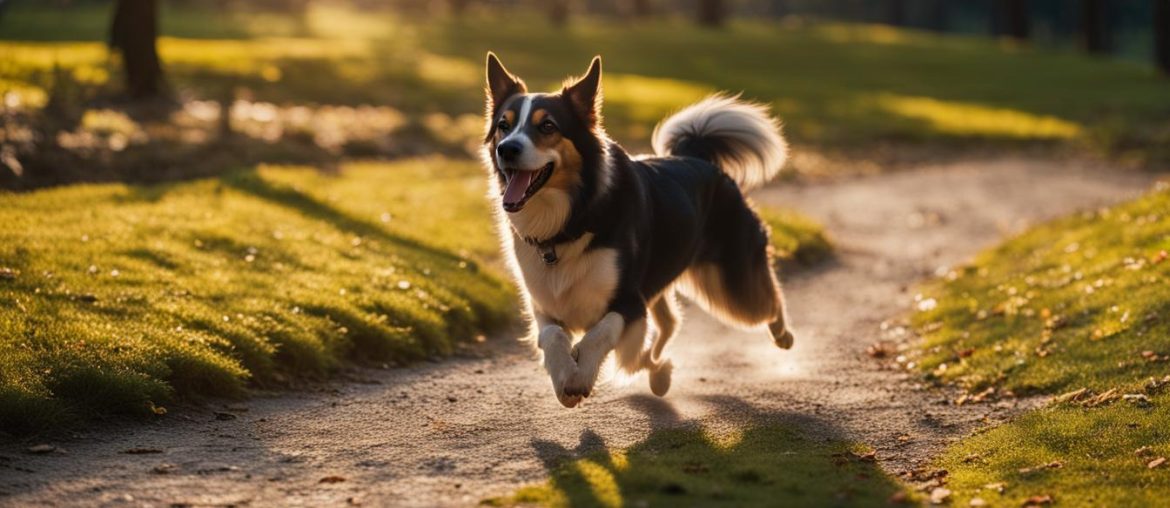Walking your dog before or after they eat can have benefits and risks, just like with humans. When walking your dog before they eat, it is important to keep the activity moderate and to not push them too hard. This will help them digest their food and give them time to rest and relax before or after their meal. On the other hand, walking your dog after they eat can help them burn off some energy and may even help them digest their food more easily. It is best to wait at least an hour after feeding your dog before taking them for a walk. This will give them time to digest their food and relax. Puppies and senior dogs may need more rest and less activity than adult dogs, so it is important to consult with your veterinarian for the best plan for your individual dog.
Key Takeaways:
- Walking your dog before they eat can help them digest their food and rest.
- Walking your dog after they eat can help burn off energy and aid digestion.
- Wait at least an hour after feeding your dog before walking them.
- Puppies and senior dogs may need more rest and less activity.
- Consult with your veterinarian for personalized advice.
Risks of Walking Your Dog After They’ve Finished Eating

Walking your dog immediately after they’ve finished eating can pose several risks. One of the main risks is the potential for bloating, which can lead to gastric torsion, a life-threatening condition in dogs. Bloating occurs when the stomach fills with gas or fluid, causing it to expand and potentially twist. Large breed dogs with deep chests are especially susceptible to this condition, but it can affect any dog. Symptoms of bloating include a swollen or distended abdomen, restlessness, pacing, drooling, and unproductive attempts to vomit.
Aside from bloating, there are other risks associated with walking your dog right after a meal. Overheating is a concern, particularly if the weather is hot or humid. Dogs have a harder time regulating their body temperature compared to humans, and intense exercise after eating can put them at risk of heatstroke. Vomiting is another potential risk, as the physical activity may cause the food to be expelled prematurely. This can lead to further digestive issues and discomfort for your furry companion.
Ingesting foreign objects is also a concern when walking your dog after they’ve eaten. When dogs are out and about, they may come across tempting items on the ground, such as discarded food or trash. If they’re still in the process of digesting their meal, they may be more prone to scavenging and potentially ingesting something harmful. This can cause gastrointestinal distress and inflammation, leading to further complications and discomfort for your dog.
Possible Risks of Walking Your Dog After They’ve Finished Eating:
- Bloating and potential gastric torsion
- Overheating and risk of heatstroke
- Vomiting and digestive issues
- Ingesting harmful foreign objects
- Gastrointestinal distress and inflammation
It is important to wait at least an hour after your dog has finished eating before taking them for a walk to minimize these risks. This allows sufficient time for digestion and reduces the likelihood of complications. If you’re unsure about the appropriate waiting period for your dog, consult with your veterinarian for guidance based on their specific needs and health condition.
How Long Should You Wait Before You Feed Your Dog After Exercise?
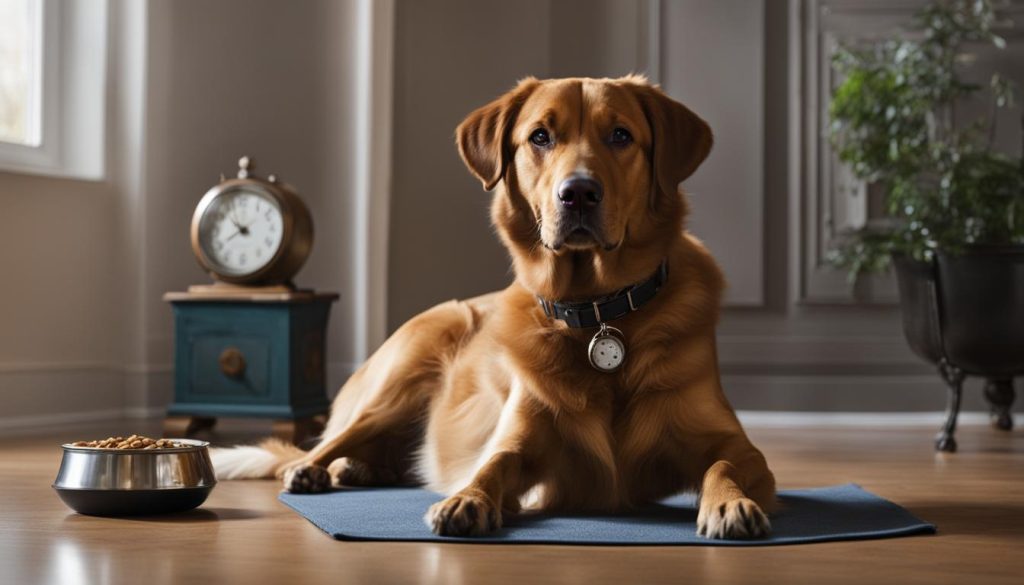
After your dog has engaged in vigorous exercise, it is crucial to allow their body to cool down and recover before providing them with their next meal. Waiting approximately an hour after exercise before feeding your dog is recommended. This timeframe allows your dog’s system to regulate itself and prevents any potential complications that may arise from feeding them immediately after physical activity.
Feeding Schedule and Portions
The amount of food you give to your dog after exercise should be adjusted based on the intensity and duration of their workout. It is advisable to offer smaller meals and avoid feeding them foods that are high in fat. By providing your dog with the right nutrition after exercise, you promote their recovery and overall health. Consult with your veterinarian for specific feeding recommendations tailored to your dog’s needs.
Dog’s Energy Replenishment
After exercise, it is important to replenish your dog’s energy levels. By waiting for an appropriate period before feeding them, you give their body enough time to restore its balance. This ensures that their digestive system is not overwhelmed and allows for optimal energy absorption from their meal. Providing your dog with the necessary time for energy replenishment contributes to their overall well-being and supports their continued physical activity.
Risks of Walking Your Dog Before They’ve Eaten
Walking your dog before they’ve eaten can pose some risks that pet owners should be aware of. These risks include over-exertion, distraction, and potential gastrointestinal issues.
Over-exertion
One of the risks of walking your dog before they’ve eaten is over-exertion. If your dog becomes overly tired during the walk, they may not have enough energy left to properly digest their food. This can lead to discomfort and digestive issues.
Distraction
Another risk is distraction. When dogs are hungry, they may be more focused on finding food during the walk rather than paying attention to their surroundings. This can lead to accidents or dangerous situations, such as running into traffic or eating something harmful.
Gastrointestinal Issues
Walking before eating can disrupt the digestion process, potentially causing gastrointestinal issues such as bloating or vomiting. The body needs time to properly process and absorb nutrients from the food, and walking immediately before eating can interfere with this process.
| Risks of Walking Your Dog Before Eating |
|---|
| Over-exertion |
| Distraction |
| Gastrointestinal Issues |
It’s important to consider these risks before deciding whether to walk your dog before they’ve eaten. Every dog is different, and what works for one may not work for another. Consulting with your veterinarian can provide valuable guidance on the best routine for your dog’s specific needs and health.
Benefits of Walking Your Dog Before They’ve Eaten
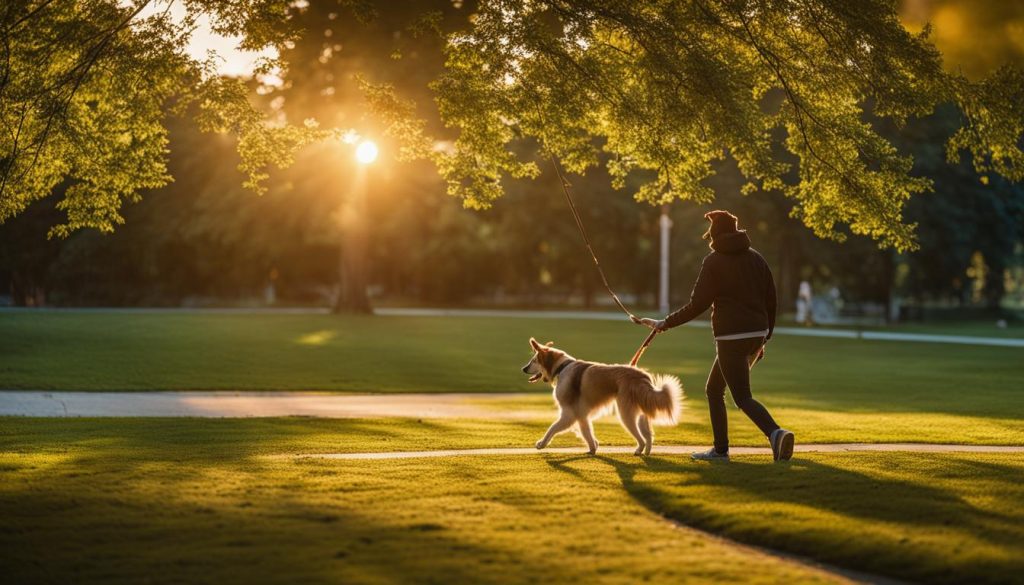
Walking your dog before they’ve eaten can have numerous benefits for their physical and mental well-being. Let’s explore some of these advantages:
1. Burning Energy
Taking your dog for a walk before their meal can help them burn off excess energy accumulated during the day. This is especially beneficial for high-energy breeds or younger dogs who may have a surplus of energy to expend. By giving them the opportunity to stretch their legs and engage in physical activity, you can help keep them calm and content throughout the day.
2. Mental Stimulation
A walk before mealtime provides mental stimulation for your furry friend. They get the chance to explore their surroundings, encounter new sights and smells, and engage with their environment. This mental exercise helps keep their minds sharp and can reduce boredom or destructive behavior at home.
3. Gastric Motility and Digestion
Walking before eating can promote gastric motility, which refers to the movement of food through the gastrointestinal tract. The physical activity helps stimulate the digestive process, aiding in the efficient breakdown and absorption of nutrients from their meal. This can contribute to better digestion and overall gastrointestinal health for your dog.
4. Stress Reduction and Bond Strengthening
Walking your dog before they eat can also help reduce stress and strengthen the bond between you and your furry companion. The shared experience of exploring the outdoors together can create a sense of trust and companionship. Additionally, being in nature and enjoying the fresh air can have a calming effect on both you and your dog, promoting relaxation and reducing anxiety.
By incorporating a walk before mealtime into your dog’s routine, you can provide them with physical exercise, mental stimulation, and a stronger bond with you. Remember to consider your individual dog’s needs and consult with a veterinarian to establish the best approach for their specific requirements.
Is There a Best Time to Feed Your Dog?

Feeding your dog at the right time is crucial for their overall health and well-being. Establishing a consistent feeding schedule can help regulate their digestion, energy levels, and prevent behavior issues. Most experts recommend feeding your dog twice a day, once in the morning and once in the evening.
For many dogs, the morning feeding provides them with the necessary energy for the day ahead. It can also help establish a routine and promote regular bathroom habits. However, some dogs may prefer to go for a walk or engage in exercise before their morning meal, especially if they have a larger appetite later in the day.
The evening feeding is essential to keep your dog satisfied overnight and manage their hunger levels. This feeding should ideally be given a few hours before bedtime to allow for proper digestion. Please be aware that the amount of food and the timing of meals may vary depending on your dog’s size, breed, age, and activity level. Consulting with your veterinarian can help determine the best feeding schedule for your individual dog.
| Feeding Time | Benefits |
|---|---|
| Morning | Provides energy for the day, establishes routine, promotes regular bathroom habits |
| Evening | Keeps dog satisfied overnight, manages hunger levels |
Summary:
- Feeding your dog twice a day, morning and evening, is recommended by experts.
- The morning feeding provides energy for the day ahead and establishes a routine.
- The evening feeding keeps your dog satisfied overnight and manages hunger levels.
- Consulting with your veterinarian can help determine the best feeding schedule for your individual dog.
Should You Feed or Walk Your Dog First in the Morning?
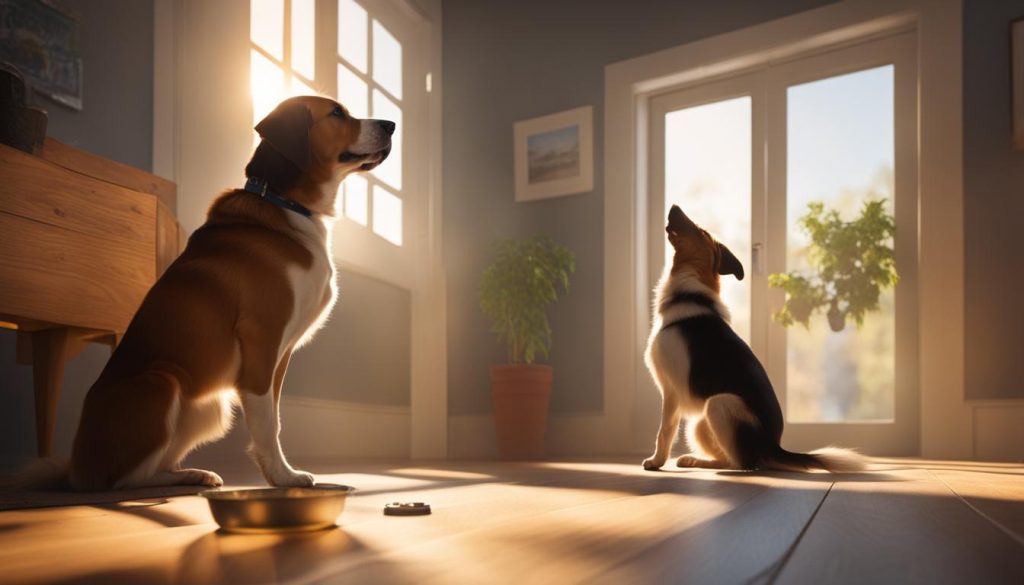
When it comes to establishing a morning routine for your dog, you may be wondering whether to feed them first or take them for a walk. The answer ultimately depends on your dog’s individual needs and preferences. Some dogs may prefer to go for a walk first thing in the morning, while others may benefit from having breakfast before heading out. Let’s explore the pros and cons of each approach to help you make an informed decision.
Walking Your Dog First
Walking your dog before feeding them in the morning can have its advantages. Taking your dog for a walk first thing can help burn off any excess energy and stimulate their mind. It can also provide an opportunity for them to relieve themselves before settling down for their meal. For some dogs, a walk in the morning can be a great way to start the day and establish a regular routine.
Feeding Your Dog First
On the other hand, feeding your dog before their morning walk can also have its benefits. Having breakfast can provide them with the energy they need for their walk, ensuring they have enough stamina to enjoy their exercise. It can also help establish a routine where your dog knows that breakfast comes before a morning walk. Additionally, feeding your dog before their walk can prevent distractions during mealtime, as they may be more focused on their walk if they have already eaten.
Ultimately, whether you choose to feed or walk your dog first in the morning depends on what works best for both you and your furry friend. Consider your dog’s energy levels, preferences, and overall routine to determine the most suitable approach. Remember to provide them with ample time to digest their food before engaging in any strenuous exercise to avoid discomfort or digestive issues. Consulting with your veterinarian can also provide valuable insights tailored to your dog’s specific needs and well-being.
Eating and Walking: Poop Schedule
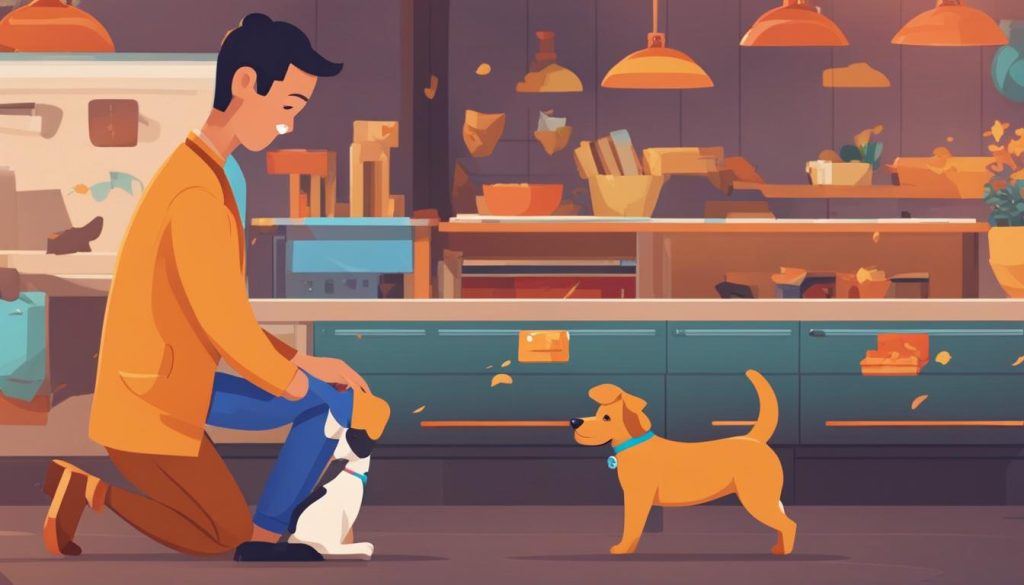
Taking your dog for a walk after they’ve eaten is not only beneficial for their physical health but also plays a crucial role in establishing a healthy bathroom routine. Puppies, in particular, have a tendency to need to relieve themselves soon after a meal. By taking them outside immediately after eating, you can help them develop a regular toilet schedule and avoid accidents indoors.
As dogs age, their bathroom habits may change, but it is still important to provide them with opportunities to relieve themselves after meals. By walking your dog after they’ve eaten, you are giving them the chance to eliminate any waste that may have built up in their digestive system. This can help prevent discomfort and potential accidents inside your home.
| Age Group | Bathroom Needs after Eating |
|---|---|
| Puppy (8 weeks to 6 months) | High urgency; need to go outside immediately after eating |
| Adult Dog (6 months and older) | May have a slightly longer delay before needing to relieve themselves |
| Senior Dog (7 years and older) | May have varying bathroom needs; consult with a veterinarian for specific guidance |
Establishing a consistent routine for bathroom breaks after meals can help prevent accidents and promote good hygiene. Remember to always have waste disposal bags on hand during walks to clean up after your dog. Maintaining a regular poop schedule is essential for their overall well-being and ensures a clean and healthy environment for both you and your furry friend.
Wrapping Up
After examining the benefits and risks of walking your dog before and after eating, it is clear that there are best practices to consider. When walking your dog after they’ve eaten, it is crucial to wait at least an hour to allow for proper digestion and minimize the risk of bloating and discomfort. This timing also ensures that your dog has ample rest and relaxation after their meal.
On the other hand, walking your dog before they eat can help establish a routine and prevent distractions during mealtime. It can provide mental stimulation, burn off excess energy, and strengthen the bond between you and your dog. However, it is important to ensure that your dog does not become over-exerted and unable to properly digest their food.
Ultimately, the best approach depends on your individual dog’s needs and preferences. Consulting with your veterinarian can provide valuable insights into the optimal feeding and walking schedule for your furry friend. By taking your dog’s age, health, and energy level into account, you can create a routine that promotes their overall well-being and keeps them happy and healthy.
FAQ
Can I walk my dog 30 minutes after eating?
It is best to wait at least an hour after feeding your dog before taking them for a walk.
What are the risks of walking my dog after they’ve finished eating?
Risks include bloating, overheating, vomiting, ingesting foreign objects, gastrointestinal distress, and inflammation.
How long should I wait before feeding my dog after exercise?
It is best to wait at least an hour before feeding your dog after vigorous exercise.
What are the risks of walking my dog before they’ve eaten?
Risks include over-exertion and potential gastrointestinal issues.
What are the benefits of walking my dog before they’ve eaten?
Benefits include burning energy, mental stimulation, promoting gastric motility, reducing stress, and strengthening the bond.
Is there a best time to feed my dog?
Most experts recommend feeding your dog twice a day, once in the morning and once in the evening.
Should I feed or walk my dog first in the morning?
It depends on your dog’s individual needs and preferences. Some dogs may prefer to go for a walk first, while others may benefit from eating before a walk.
What about the poop schedule for my dog?
Taking your dog for a walk after they’ve eaten can help establish healthy bathroom habits, especially for puppies.
What are the best practices for walking my dog after eating?
It is important to wait at least an hour before walking your dog and to ensure they have time to digest their food. Consult with your veterinarian for personalized advice.


